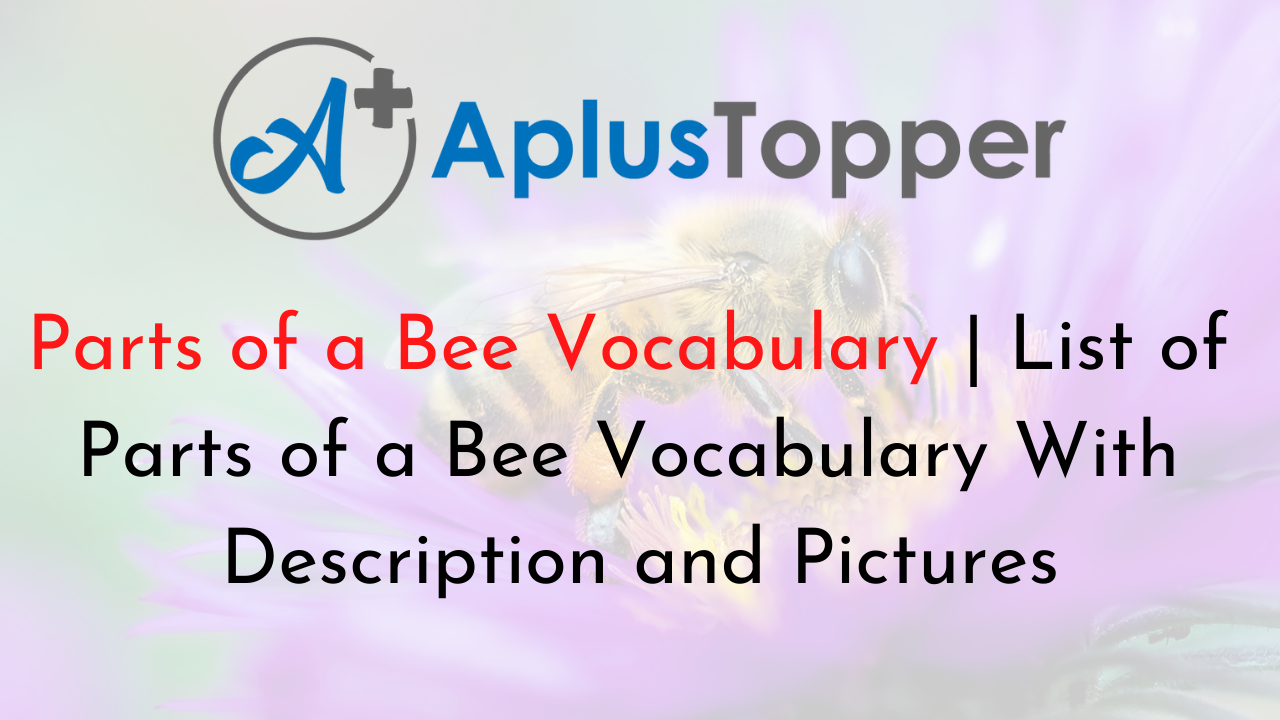Parts of a Bee Vocabulary: Bee is a flying insect referred to as the busiest creature. It plays a crucial role in pollination and gives us honey. However, bees are not very friendly and may sting if they sense danger. A bee sting causes a very severe allergic reaction in the body, but it is often self-treated as it requires a speedy solution.
We can look at a bee anatomy parts, or body parts of honey bee in detail study the words in detail to find out more about them. To make your learning experience better, we’ve come up with a list of parts of bee vocabulary words. It is a set of basic body parts easy to memorize.
List of Parts of a Bee Vocabulary Words in English
Name of Parts of a Bee Vocabulary Words
In the English Language, there is a wide range of parts of bee words. We can label a simple bee diagram with the help of the necessary words. The study of honey bees states an interesting fact. Bees who search for nectar or help in pollination away from any hive don’t sting in fear.
To help you find the parts of a bee body, you will need to know the exact vocabulary of words. We have come up with a list for you. Therefore, this article will act as a guide to know the body parts of honey bee.
List of Parts of a Bee
Description of the Parts of a Bee Vocabulary Words
Head
A bee’s parts are divided into three main parts, one of which is a triangle-shaped head. The head of a bee includes organs like eyes, antennae, proboscis, etc., and is referred to as the powerhouse. It allows the bee to know about their surroundings, familiar landmarks, and whether the weather is suitable for flying.
Thorax
The second or middle section. The Thorax of a bee contains three pairs of legs and two pairs of wings. It makes the Thorax responsible for all the motion. It allows bees to move from their hive, collect nectar, walk, fly and even reproduce.
Abdomen
It is the last and crucial part of a bee which includes organs that control digestion, respiration, and circulation. In addition, it holds the reproductive organ of male bees and queen bees. Males have testes to hold their semen, and queen bees have spermatheca to hold semen and large ovaries to produce eggs.
Tongue
The tongue of bees is called a proboscis. It has a straw-like structure with a pointed front. It can be extended up to a quarter-inch long and can be rolled back. The tongue is used to taste and reach the nectar, which the brain collects by sucking it from the tongue.
Spiracle
Bees do not have lungs to conduct respiration. Instead, they have sacs in the abdomen and head there to help in respiration. It allows oxygen to enter through the tracheal system, leading to oxygen absorption and release of carbon dioxide.
Mandibles
The mandible is composed of several bones making a strong jaw attached to the head at the ends of the labrum. Mandibles are different for worker bees and queen bees. Queen bees have pointed mandibles to bite and support cutting, whereas workers have smooth surfaces to produce wax.
Compound eye
Bees have a set of five eyes, and a total comprises two large eyes called compound eyes. The compound eyes of bees are made up of thousands of individual lenses and are situated on both sides of the head.
Compound eyes recognize shape, color, and other reflex images, and its special feature is providing images in all different angles.
Simple eye
The simple eye of bees is also called ocelli. Ocelli eyes are three in number located at the center of the head. These help the bees to sense sunlight and navigate them throughout the day. Simple eyes in bees prevent them from doing any activity at night.
Wings
Bees have four wings attached to the Thorax. The two wings in front are called forewings, and the other two at the back are called hind wings. The wings can carry the weight of a baby and lift it for a special propeller-like twist feature. The wings are larger than compared to hind wings, but both help in flying.
Legs
The legs of honey bees are very flexible, being split into six segments and three pairs. The front legs clean the antennae, and the back legs guide in pollen collection and moving it to the pollen basket.
The legs of Queen bees and worker bees work differently, and they both have different sets of legs. Legs of male bees are designed to brush, collect and carry Pollen and carry it back to the hive to make honey.
Pollen basket
A pollen basket is a part of bees covered with hairs found in the tibia or the hind legs. The hairs help the basket stay in place. After collecting nectar from flowers, honey bees collect Poland and store it in a sac-like formation on their legs; this is called a pollen basket.
Stinger
Bees body is very delicate and has a fragile body. Therefore, the stinger is the only defense system present in them. Singer act in different ways for males and females. It is a modified organ that can lay eggs for queen bees, whereas it acts as a defense mechanism for male or worker bees.
One interesting fact about tigers is that honey bees can only sting once as they become detached after inserting it into a body.
Antennae
A bee’s antennae allow it to sense any chemicals or vibrations, danger, electricity, light, etc. Antennae are the most crucial part of a bee’s organ to protect them from danger in the environment.
Male bees or worker bees have longer antennae than queen bees. Males have this special feature two pickups sent from female bees and sense danger.
